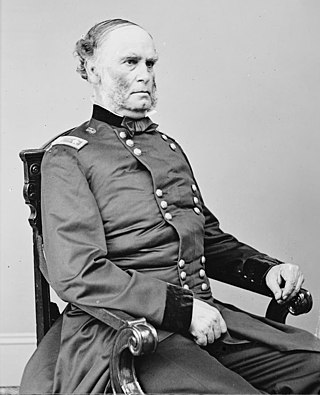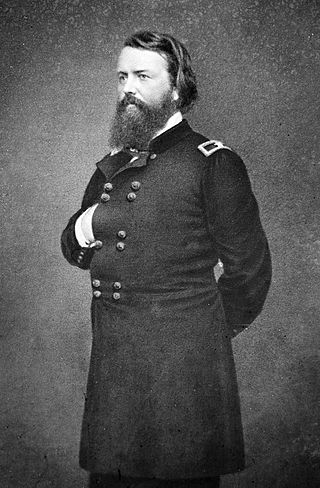Related Research Articles

Samuel Ryan Curtis was an American military officer and one of the first Republicans elected to Congress. He was most famous for his role as a Union Army general in the Trans-Mississippi Theater of the American Civil War, especially for his victories at the Battles of Pea Ridge in 1862 and Westport in 1864.

The territory of the United States and its overseas possessions has evolved over time, from the colonial era to the present day. It includes formally organized territories, proposed and failed states, unrecognized breakaway states, international and interstate purchases, cessions, and land grants, and historical military departments and administrative districts. The last section lists informal regions from American vernacular geography known by popular nicknames and linked by geographical, cultural, or economic similarities, some of which are still in use today.

John Pope was a career United States Army officer and Union general in the American Civil War. He had a brief stint in the Western Theater, but he is best known for his defeat at the Second Battle of Bull Run in the East.
Department is an organizational term used by the U.S. Army, mostly prior to World War I, to describe named geographical districts created for control and administration of installations and units. In 1920, most of the named departments were redesignated as numbered Corps Areas. However, the Hawaiian, Panama Canal, and Philippine Departments retained their old names. In 1939, the Puerto Rican Department was created and in May 1941 the Panama Canal and Puerto Rican Departments were combined as the Caribbean Defense Command, although each was still referred to as a department.
Army of the Mississippi was the name given to two Union armies that operated around the Mississippi River, both with short existences, during the American Civil War.

Andrew Jackson Smith was a United States Army general during the American Civil War, rising to the command of a corps. He was most noted for his victory over Confederate General Stephen D. Lee at the Battle of Tupelo, Mississippi, on July 14, 1864.

The Army of Missouri was a Confederate field army during the American Civil War that served as part of the Trans-Mississippi Department. It was established in September 1864 under the command of Major General Sterling Price to invade Missouri. The fall campaign was unsuccessful, and the army retreated to Arkansas, where it was broken up and reabsorbed into the Army of the Trans-Mississippi.
The Department of the Pacific or Pacific Department was a major command (Department) of the United States Army from 1853 to 1858. It replaced the Pacific Division, and was itself replaced by the Department of California and the Department of Oregon.

The western theater of the American Civil War encompassed major military operations in the states of Alabama, Georgia, Florida, Mississippi, North Carolina, Kentucky, South Carolina and Tennessee, as well as Louisiana east of the Mississippi River. Operations on the coasts of these states, except for Mobile Bay, are considered part of the Lower Seaboard Theater. Most other operations east of the Appalachian Mountains are part of the eastern theater. Operations west of the Mississippi River took place in the trans-Mississippi theater.
The trans-Mississippi theater of the American Civil War was the scene of the major military operations west of the Mississippi River. The area is often thought of as excluding the states and territories bordering the Pacific Ocean, which formed the Pacific coast theater of the American Civil War (1861–1865).
The Department of the Ohio was an administrative military district created by the United States War Department early in the American Civil War to administer the troops in the Northern states near the Ohio River.
The Department of the Missouri was a command echelon of the United States Army in the 19th century and a sub division of the Military Division of the Missouri that functioned through the Indian Wars.

Daniel Marsh Frost was a former United States Army officer who became a brigadier general in the Missouri Volunteer Militia (MVM) and the Confederate States Army during the American Civil War. Among the handful of Confederate generals born in the North, Frost led the MVM during the Camp Jackson affair in May 1861 that fanned civil unrest in St. Louis.

The Army of Central Kentucky was a military organization within Department No. 2. Originally called the Army Corps of Central Kentucky, it was created in the fall of 1861 as a subsection of Department No. 2, and continued in existence until the end of March 1862 when it was absorbed and merged into the Army of Mississippi, which was then re-organized as the Army of Tennessee on November 20, 1862.
William Steele was a career military officer and businessman who served as the 16th adjutant general of Texas from 1874 until 1879. He previously served as a senior officer of the Confederate States Army who commanded cavalry in the Trans-Mississippi Theater of the American Civil War.

The Frémont Emancipation was part of a military proclamation issued by Major General John C. Frémont (1813–1890) on August 30, 1861, in St. Louis, Missouri during the early months of the American Civil War. The proclamation placed the state of Missouri under martial law and decreed that all property of those bearing arms in rebellion would be confiscated, including slaves, and that confiscated slaves would subsequently be declared free. It also imposed capital punishment for those in rebellion against the federal government.

Enoch Steen was a United States military officer and western explorer. He joined the United States Army in 1832, serving at posts throughout the United States, including many remote locations in the west. During his military service, Steen explored parts of the western United States including large areas of southern New Mexico and southeastern Oregon. He served as the commander of several Union Army forts during the American Civil War. Today, there are landmarks in Oklahoma, Oregon, and New Mexico named in his honor; however, many of the place names are misspelled as Stein.
The Military Division of the Missouri was an administrative formation of the United States Army that functioned through the end of the American Civil War and the Indian Wars that continued after its conclusion. It was created by the War Department on February 3, 1865, at the direction of General Ulysses S. Grant to bring all the military departments west of the Mississippi River under a single commander.
During the American Civil War, a department was a geographical command within the Union's military organization, usually reporting directly to the War Department. Many of the Union's departments were named after rivers or other bodies of water, such as the Department of the Potomac and the Department of the Tennessee. The geographical boundaries of such departments changed frequently, as did their names. As the armies became larger Departments began to be subordinated to Military Divisions, and the Departments were often sub divided into Districts and from 1862 Subdistricts. Much information on Civil War departments can be found in Eicher & Eicher, Civil War High Commands.
There have been many United States historical military districts. Domestically, the United States Armed Forces has had military districts ranging from 1798 to 1881. They were reorganized several times: in 1800, in 1813, in 1815, in 1821, in 1837, in 1844, in 1848, in 1861, and in 1865. Internationally, military districts included Cuba, the Allied Military Government of Occupied Territories, South Korea, the Trust Territory of the Pacific Islands, and the Ryukyu Islands of Japan.
References
- Eicher, John H., & Eicher, David J., Civil War High Commands, Stanford University Press, 2001, ISBN 0-8047-3641-3.
- Military History at rootsweb.com